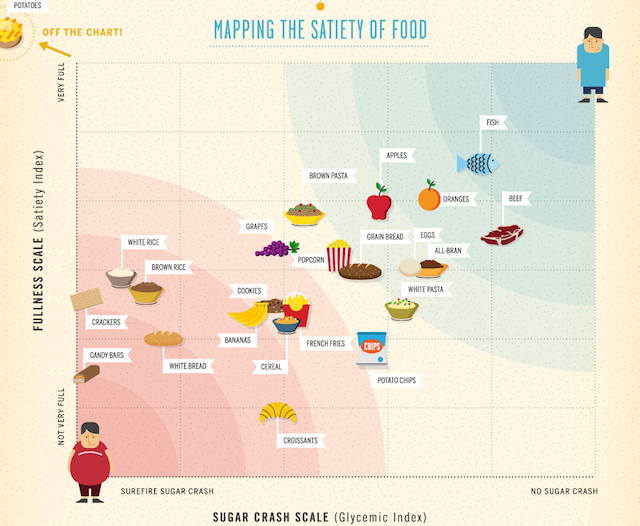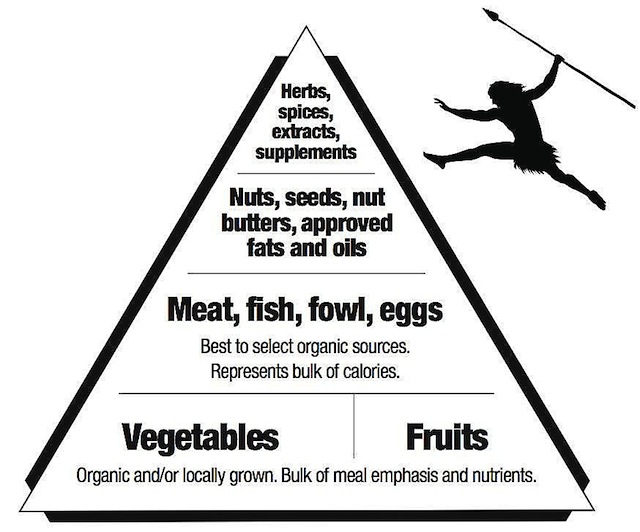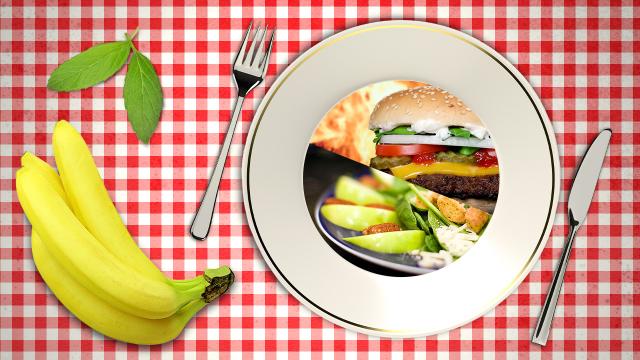I was an active kid growing up, so I didn’t worry much about food until I left home for university. I began experimenting with different eating habits to find the balance between being healthy and not entirely sacrificing foods I loved.
After almost a decade of attempting a wide range of things from “I’ll just eat what seems like it’s good for me” to strictly following the Slow-Carb Diet, I feel like I’ve finally found an eating lifestyle that I can follow forever. This lifestyle isn’t about forgetting all the food you love — it’s about creating a sustainable way of eating healthy (with the help of some clever tricks).
How Food Impacts Energy
When you’re hungry, a hormone produced in the stomach (called ghrelin) interacts with the neutrotransmitter NPY in the brain, signaling to you that your body’s energy levels are low and you need food. NPY lives in the hypothalamus, a part of your brain that controls your energy levels, memory, and emotion. In the context of food, the hypothalamus is like a 24-hour bouncer looking out for your energy, keeping constant tabs on when you need your next meal.
Once you eat, your food breaks down into glucose, which is like fuel for your brain. In order to maintain alertness, your brain functions best when there is a consistant amount of glucose in your blood. Leigh Gibson, a researcher from Roehampton University in England, noted:
The brain works best with about 25 grams of glucose circulating in the blood stream — about the amount found in a banana.
You can get this short-term glucose fix from a Snickers bar or a steak, but the trick to keep your energy levels functioning at peak performance is knowing which foods help you maintain optimal glucose levels, while at the same time making you feel full longer. In 2012, researchers at the University of Sydney created the satiety index, a guide for choosing foods to eat based on how full you’ll feel after and whether or not you’ll experience an energy crash. Here’s a visual chart of the guide, showing how different foods stack up in terms of how you can expect to feel after eating them:

This chart takes into account how quickly glucose from certain types of food get released in your bloodstream (also called a food’s glycemic index). To maintain your energy levels, you want to eat food like beans, fish, and most types of vegetables because they release glucose slowly into your bloodstream.
Meanwhile, high-carbohydrate or high-sugar foods like white bread, potatoes, and candy bars cause a rapid rise in glucose levels followed by a crash in energy. This crash happens because of a spike in the release of insulin, a hormone that tells your body to suck up as much glucose as possible, which leads to you feeling tired and unmotivated. To make matters worse, when you eat more food that’s high in carbohydrates and sugar, you need to eat even more of them to feel full.
Our Love Affair with Junk Food
Food psychologists believe that energy rich foods (like those high in fat and sugar) were attractive to early humans and needed to be taken advantage of if they became available. As a result, these foods became more desirable in order to survive. The problem is, recent research indicates that continual intake of food that’s high in fat or sugar overrides your body’s ability to tell you when you’re full. So the more unhealthy food you eat, the more you desire it.
As if it weren’t already hard enough to stop eating food high in fat and sugar, certain foods we would describe as being “crispy”, like potato chips or french fries, are even more hard-wired to be attractive to you. Millions of years ago, early primates ate a lot of insects and plants. If something our ancestors ate was crispy, it was a sign of freshness and meant that it was safe to eat.
When John Allen, a research scientist at the University of Southern California, looked at brain scans when the word “crispy” was said, he found that areas in the brain started lighting up in the same way as if the crispy food was actually being eaten. This finding was noted by Celebrity chef Mario Batali in his book The Babbo Cookbook,
“The single word ‘crispy’ sells more food than a barrage of adjectives…”
So when a menu describes a type of food as being “crispy”, you begin to have the same experience as if you are actually eating the food because of an innate desire for the sound of a crunch.
Diets Suck
The crash diet always fails. Why? Because you’re trying to break years of your own eating habits while going against human evolution all in one swoop. When researchers looked at the results across 31 studies on eating habits, they found that dieting doesn’t work in the long run. Within five years, about two-thirds of dieters gain the weight back (and sometimes more). If you regularly skip a meal as part of a diet, you’ll be hungry and your brain makes even worse food choices when you haven’t eaten in a while.
That’s exactly what a team of researchers found when they asked people to fast overnight on two different days. The first day, the participants were fed breakfast before looking at photos of high-calorie food. The second day, they were not given breakfast and then had to look at the same photos. The results of the study found that participants who were shown photos of high-calorie food without eating breakfast, showed more activation in areas of their brains that indicate desire, suggesting that fasting or dieting makes it harder to resist high-calorie food.
How I Solved the Food-Life Balance
Whether you’re starting a new career or a family (or one of the other thousand moments that will inevitably occur in your life), making what you eat a priority is the single biggest change you can make to improve how you feel, the work you do, and how you treat the people around you. I founded a company a year ago and getting my eating habits right has been a continuous experiment. It’s a work in progress, but here’s what I do to sustain a healthy eating lifestyle.
1. Cut Sugar and Starch (Gradually)
Eating too much high-sugar and high-carbohydrate food makes you feel like crap. The challenging part about trying to cut these foods out of your eating schedule is you realise that pretty much everything sold at the grocery store or made in a restaurant has either a type of sugar or starch in it. Here’s a guide that I use when buying food:

Cutting the majority of sugar and starch out of your diet is a dramatic change so you need to treat it like building a habit. When you’re creating a new habit, it’s best to start small so you don’t become overwhelmed and feel guilty if you slip up. Willpower is like a muscle, and the growth of it takes time.
When it comes to restructuring how you eat, the best thing to do is eat no high sugar or high starch foods for four days a week. After two weeks, move to five days a week. Repeat this cycle once more so you’re at six days a week of healthy eating.
2. Removing Guilt with a “Cheat Day”
I don’t want to go through life not being able to enjoy a Tim Horton’s cheese croissant once in a while (Yes, I’m an American-Canadian). Because we are modern humans and have been living with tempation from fast food restaurants and vending machines our whole lives, letting yourself go one or two days a week won’t kill you.
On your Cheat Day, you can eat whatever you want, but stop when you feel full, rather than stuffed (don’t try to eat enough junk to make up for a week or you’ll feel awful for days). If you can workout on your Cheat Day, even better. My Cheat Day foods are usually ones that have a high glycemic index (things like potatoes, french fries, and ice cream) which help in recovery from exercise.
3. Use a Mint to Master Portion Control
One of my biggest challenges is eating just enough to the point that I get full. I have the tendency to overeat, so one way I fight this is by having a mint or chewing gum once I feel full after a meal. Because of mint’s strong scent, it naturally suppresses your appetite.
That’s exactly what psychologists at the University of West Virginia found when they gave people mints to sniff throughout the day. The results of the study showed that people who inhaled mint, ate 3000 fewer calories over the week. Your sense of smell is a big part of your experience of food, so by controlling your scent you can somewhat control your appetite.
4. Replace “Crispy”
I have a mild addiction to chips. So one thing I’ve done that has worked well is replacing crispy chips with a healthier alternative that is also crispy — like a cucumber or bell pepper. Granted, a cucumber may not offer the same explosion of flavour as chips, but after I’ve eaten it, I feel better and more full, curbing my desire to want more food.
5. Never Skip Breakfast
To regulate glucose levels, you should eat within 30 minutes of waking up. Research also shows that skipping breakfast may increase how much food you end up eating at lunch. For breakfast, I’ll aim for something high in protein like an egg white omelet or oatmeal with blueberries, which keeps me feeling alert and full for hours.
What you eat reflects in everything you do. Eating well helps you be more creative, productive, and enjoyable to be around. The hard part about eating right is that there’s no plan that’s perfect for everyone. There’s no simple prescription. The only way to find what works for you is to experiment with what you eat and find something sustainable that makes you feel alive.
Clever ways to fix bad eating habits [Ooomf]
Mikael Cho is the co-founder of ooomf, a creative marketplace connecting mobile & web projects with vetted, first class developers and designers from around the world. Mikael writes more posts on psychology, startups, and product marketing over on the ooomf blog. Find him on Twitter@mikaelcho.

Comments
10 responses to “Five Tricks I Used To Beat My Unhealthy Eating Habits”
Regarding replacing “crispy”, this works. As a kid, I was into ballet and gymnastics. I determined that healthy crunchy things were better for me than baked or fried crispy things. To this day, a large baggie filled with lightly salted chunks of radish and/or celery are as satisfying a snack for me as a bag of crisps, and compared with most crisps, MORE satisfying. Fair dinkum. It’s unfortunate that chips are a lot cheaper and require less (well, no) preparation effort.
I can’t believe fish is so high on the fullness scale. Fish doesn’t fill me up at all, definitely less than beef or chicken.
comparable weights? like are you comparing how full you feel after a can of tuna to how full you feel after a 300gm porterhouse?
probs not as dense as beef or chicken? MAYBE if you ate the same mass amount of fish compared to beef, it’s better? lol dunno
One trick I used. Standing in front of the mirror naked. 7 weeks and 11% body fat later.. The title says it all
Dear Lifehacker,
You’ve posted this article without giving proper credit to where that food pyramid comes from – http://www.marksdailyapple.com – maybe update to give some credit where it’s due.
Even scanning over the article (which I didn’t, I read all of it to see how much he could he pass off as his own) he’s virtually ripped off almost all of the diet and lifestyle advice given by Mark Sission at Marksdailyapple, with thinly veiled re-wordings and large chunks left out for size. as well as missing the whole point damn point of the source material he’s ripped off.
Lifehacker would do everyone a favour by having Angus do a “Primal” challenge following the template of Primal on Marksdailyapple.com (albeit it would need to last for at least 2-3 months, no such thing as magic pills, etc.) like his Ikea Food Challenge instead of posting this poorly ripped off ‘advice’.
I get that the experiment for Ikea was not a health challenge, just trying to make a point.
That image is all over the web — haven’t seen it specifically credited to Sisson but will do some more digging. Your argument that the text has been plagiarised I don’t find convincing — I don’t think Mark Sisson is the first person to have suggested any of these dietary ideas and this post isn’t arguing for a “primal” approach. Any specific example of lifted text?
FWIW, I won’t be doing a primal challenge — not particularly convinced by that approach.
I suppose I was over enthusiastic in my criticisms and could’ve worded my whole comment better, the lessons of turning into an angry internet commentator I suppose.
I can’t give any specific examples of lifted text, I admit upon reflection I’ve drawn a thin correlation between the use of the PB Food Pyramid and the rest of the article, however the direction of the advice is resonant of what Sission writes about in any case. Ripped off was the wrong way to say what I was trying to say.
http://www.marksdailyapple.com/introducing-the-new-primal-blueprint-food-pyramid/#axzz2e3x3UI2q – here’s where the Pyramid is from (out of a book he published). Comments isn’t the place, but I’d love to know what isn’t convincing for you about the approach?
Thanks for the taking the time to reply, I wasn’t expecting as much given my tone.
Sidebar: I’m a fan of the content you create or report on, you’re always well written and informed. I do really like Lifehacker AU.
I’ve been gradually adding in more fresh fruit and vegetables as well as seeds and nuts while cutting back on unhealthy snacks. Eventually I figure I’ll end up changing the junk food carvings for health food cravings. I’m also cutting back on soft drink and having some herbal tea with snacks or meals instead (trying to get into rooibos tea as it’s apparently packed full of antioxidants. It’s an acquired taste though).
Having said all that though, it’s ok to have junk food/snacks when your crave them (so long as it’s not the only thing you’re eating) because I’ve found if I specifically think “I can’t have this” I end up wanting exactly that, which naturally makes things really hard when I’m trying to be healthy.
“Research analysing 235 types of rice from around the world has found its glycemic index (GI) varies from one type of rice to another with most varieties scoring a low to medium GI.”
Which rice was used on this scale? It seems to have been placed on the very extreme GI side of the picture….
The only rice that isn’t high on the GI scale is basmati. Jasmine rice is 107 on the GI scale, where glucose is 100. It’s not as healthy as one might think.